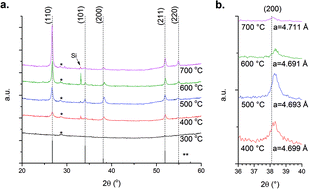By investigating the influence of key growth variables on the measured structural and electrical properties of SnO2 prepared by pulsed laser deposition (PLD) we demonstrate fine control of intrinsic n-type defect formation. Variation of growth temperatures shows oxygen vacancies (VO) as the dominant defect which can be compensated for by thermal oxidation at temperatures >500 °C. As a consequence films with carrier concentrations in the range 1016–1019 cm−3 can be prepared by adjusting temperature alone. By altering the background oxygen pressure (PD) we observe a change in the dominant defect – from tin interstitials (Sni) at low PD (<50 mTorr) to VO at higher PD with similar ranges of carrier concentrations observed. Finally, we demonstrate the importance of controlling the composition target surface used for PLD by exposing a target to >100 000 laser pulses. Here carrier concentrations >1 × 1020 cm−3 are observed that are associated with high concentrations of Sni which cannot be completely compensated for by modifying the growth parameters.
